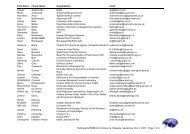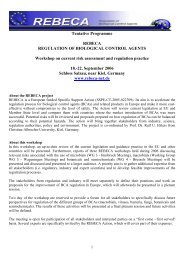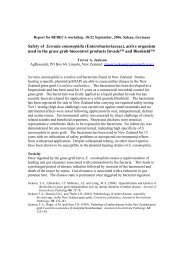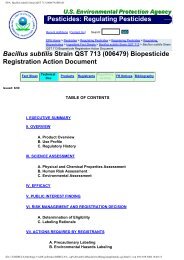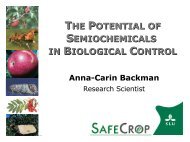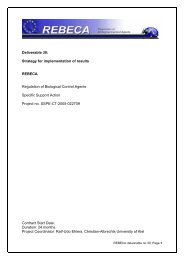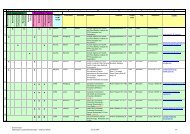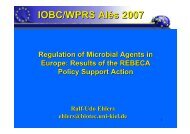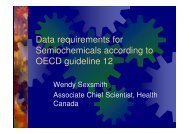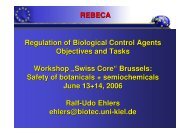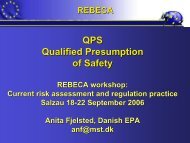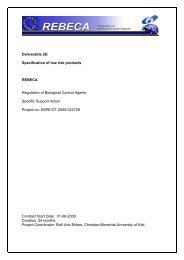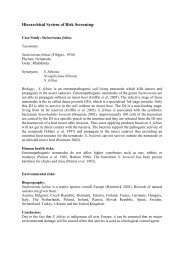Microbial & Biochemical - REBECA
Microbial & Biochemical - REBECA
Microbial & Biochemical - REBECA
Create successful ePaper yourself
Turn your PDF publications into a flip-book with our unique Google optimized e-Paper software.
<strong>Microbial</strong> & <strong>Biochemical</strong><br />
US Environmental Protection Agency<br />
US Environmental Protection Agency<br />
Office of Pesticide Programs<br />
Office of Pesticide Programs<br />
Biopesticides & Pollution Prevention Division<br />
Biopesticides & Pollution Prevention Division<br />
William R. Schneider, Ph.D.<br />
William R. Schneider, Ph.D.<br />
schneider.william @ epa.gov<br />
schneider.william 703-308-8683@ epa.gov<br />
703-308-8683<br />
Pesticide Data Requirements
<strong>Microbial</strong> & <strong>Biochemical</strong><br />
Pesticides<br />
• The first microbial pesticide was<br />
registered in 1948<br />
• Mid 1970’s – began development of<br />
data requirements<br />
• <strong>Microbial</strong> Pesticides needed different<br />
kinds of tests<br />
• Some naturally-occurring chemical<br />
pesticides could be evaluated with a<br />
reduced set of data requirements.<br />
1
History<br />
2<br />
• NSF report - 1977<br />
– Biological Substitutes for Chemical Pesticides,<br />
• Proposed Data requirements – all Pesticides<br />
– Published FR July 10, 1978 (40 CFR 163)<br />
– Biocontrol organisms – case by case data<br />
• Policy statement: Regulation of Biorationals<br />
– Published FR May 14, 1979<br />
• American Institute of Biological Sciences - 1979<br />
– Human Hazard Evaluation Scheme for Biorationals<br />
• Subdivision M guidelines 1982, NTIS<br />
• Data Requirements – all Pesticides<br />
– 40 CFR 158 (FR October 24, 1984) (1983 SAP)
History (people)<br />
3<br />
• Martin Rogoff<br />
• Reto Engler<br />
• Fred Betz<br />
• Al Vaughan<br />
• Ron Ney<br />
• Bob Hitch<br />
• Stuart Cohen<br />
• Bill Preston<br />
• Ed Gray<br />
• Amy Rispin<br />
• Bill Schneider<br />
• Roy Sjoblad<br />
• Tom McClintock<br />
• Janet Andersen<br />
• Debby Edwards<br />
• Morris Levin<br />
• Zig Vaituzsis<br />
• Doug Urban<br />
• Bob Pilsucki<br />
• Bill Hazel<br />
• John Couch (ORD)<br />
• Clint Kawanishi (ORD)<br />
• Anne Fairbrother (ORD)<br />
• Fred Genthner (ORD)<br />
• Clay Beegle<br />
• John Kough<br />
• David Bays<br />
• Bob Rose<br />
• Phil Hutton<br />
• Willie Nelson
<strong>Microbial</strong> Pesticides: The Past 20 years<br />
• Pre-1984: 17 microbial<br />
pesticides were<br />
registered<br />
• Post- 1984: Over 70<br />
microbial pesticides<br />
registered<br />
60<br />
50<br />
40<br />
30<br />
20<br />
10<br />
0<br />
Pre-1984<br />
Post-<br />
1984<br />
4
History<br />
• Subdivision M guidelines revision, NTIS<br />
1989 (1988 SAP)<br />
• Draft 40 CFR 158 Data Requirements<br />
– Corresponded to the revised guidelines<br />
– Presented to, and approved by the SAP 1994<br />
– Not published pending revision of other 158<br />
sections<br />
• Harmonized Guideline revisions 1995<br />
– published on internet<br />
– Some still being revised<br />
5
Scope of this Proposal<br />
6<br />
• Clarify definitions<br />
– biochemical (40 CFR Part 158)<br />
– microbial pesticides (40 CFR Parts 158 and 172)<br />
• Update data requirements for biochemical and<br />
microbial pesticides<br />
• Presentation format:<br />
– Discuss <strong>Microbial</strong>s & then <strong>Biochemical</strong>s<br />
• Definitions described first<br />
• Data requirement changes described second<br />
–1 st slide will show original 1982 data requirements<br />
– The following slide(s) will present changes in red text<br />
– Deleted data requirements will be crossed out<br />
– Test name changes will appear in italics
Data Requirements Revisions<br />
7<br />
• Current tables reference 1982 guidelines<br />
– changed to harmonized guideline (numbers & names)<br />
• Some studies are no longer needed<br />
– Some harmonized guidelines were never written<br />
• Because we don’t expect to need them<br />
• The tests wouldn’t give answers we could use<br />
– We currently have to ask for waivers for each one<br />
• Some new studies have been added<br />
– To provide better options to evaluate positive results seen at lower<br />
tiers.<br />
– To harmonize with conventional pesticides<br />
• Test substances (TGAI, MP, EP) have been changed for<br />
some tests<br />
• Test notes have been revised to give better guidance.
<strong>Microbial</strong> Pesticides<br />
definition<br />
8<br />
• Original:<br />
– <strong>Microbial</strong> pesticides include microbial entities such as<br />
bacteria, fungi, viruses, and protozoans.<br />
• Proposed:<br />
– <strong>Microbial</strong> pesticide is a microorganism intended for<br />
preventing, destroying, repelling, or mitigating any<br />
pest, or intended for use as a plant regulator, defoliant,<br />
or dessicant, that:<br />
(1) Is a eucaryotic microorganism including, but not<br />
limited to, protozoa, algae, and fungi;<br />
(2) Is a procaryotic microorganism, including, but not<br />
limited to, bacteria; or<br />
(3) Is an autonomous replicating microscopic element,<br />
including but not limited to, viruses.
<strong>Microbial</strong> Pesticides<br />
78 registered<br />
9<br />
• Bacteria (39)<br />
– 17 Bacillus thuringiensis subspecies<br />
– 10 other Bacillus species<br />
– 10 Pseudomonas species<br />
– 2 Agrobacterium isolates<br />
• Fungi (29)<br />
• Baculoviruses (7)<br />
•Yeast(2)<br />
• Protozoa (1 )
Risk Assessment<br />
10<br />
• Hazard<br />
– Toxicity, Pathogenicity<br />
• Exposure<br />
– Biopesticide aspects<br />
• Scale of use, use patterns, application rates<br />
• Persistence, degradation, mobility<br />
• <strong>Microbial</strong>s: Population dynamics, infectivity, residues<br />
– Used less for microbial pesticides<br />
• Difficult analysis for microbials that multiply in the<br />
environment<br />
• <strong>Microbial</strong> toxins may need analysis<br />
– <strong>Biochemical</strong> pesticides occur naturally in the<br />
environment<br />
• Exposure data required only if toxicity concerns are identified<br />
• Risk<br />
– Non-targets, humans, domestic animals, endangered<br />
species
<strong>Microbial</strong> Data Requirements<br />
(original)<br />
• Product Analysis<br />
– Product Identity***<br />
– Manufacturing Process<br />
– Discussion of unintended ingredients<br />
– Analysis of samples<br />
– Certification of limits<br />
– Analytical methods<br />
– Physical & Chemical Properties<br />
– Submittal of samples<br />
11
<strong>Microbial</strong> Data Requirements<br />
(proposed)<br />
• Product Analysis<br />
– Produc Identity***<br />
– Manufacturing Process<br />
– Discussion of unintended ingredients<br />
– Analysis of samples<br />
– Certification of limits<br />
– Analytical methods (moved to Product ID)<br />
– Physical & Chemical Properties (itemized)<br />
– Submittal of samples (to culture collection)<br />
12
<strong>Microbial</strong> Data Requirements<br />
(original)<br />
• Human Health Tier 1 Studies<br />
– Oral toxicity/pathogenicity - 3 dose levels<br />
– Dermal tox/path<br />
– Pulmonary tox/path<br />
– Iv, ip, ic tox/path<br />
– Immune response<br />
– Tissue culture – for viruses<br />
– Acute studies on formulated product<br />
– Toxicity: oral, inhalation, dermal<br />
– Irritation: eye, dermal (may include toxicity)<br />
– Hypersensitivity study<br />
– Hypersensitivity reporting<br />
13
<strong>Microbial</strong> Data Requirements<br />
(proposed)<br />
• Human Health Tier 1 Studies<br />
– Oral toxicity/pathogenicity – Maximum Hazard Dose<br />
– Dermal tox/path – (replaced by Dermal toxicity)<br />
– Pulmonary tox/path<br />
– Iv, ip, ic tox/path – ic exposure not practical<br />
– Immune response - not relevant for microbials<br />
– Cell culture – for viruses<br />
– Acute studies on formulated product<br />
– Toxicity: oral, inhalation, dermal<br />
– Irritation: eye, dermal (if irritation seen in dermal tox study)<br />
– Hypersensitivity study (not relevant for microbials)<br />
– Hypersensitivity reporting<br />
14
<strong>Microbial</strong> Data Requirements<br />
If effects seen in Tier I Human Health (original)<br />
• Tier II Studies<br />
– Acute toxicity oral & inhalation (viruses & protozoa)<br />
– Subchronic oral (protozoa)<br />
– Residue studies<br />
– Ip/ic tox path (2 other species, 4/6 months duration)<br />
– Primary eye/dermal (dose: the use dilution of EP)<br />
– Immune response (no protocols in old guidelines)<br />
– Teratogenicity (for viruses that damage cell cultures)<br />
– Virulence Enhancement (LD50 after serial passage)<br />
– Mammalian mutagenicity (dosing: microorganisms)<br />
15
<strong>Microbial</strong> Data Requirements<br />
If effects seen in Tier I Human Health (proposed)<br />
• Tier II Studies<br />
– Acute toxicity (evaluate any toxicity seen in Tier I)<br />
– Subchronic (evaluate any persistence without toxicity)<br />
– Residue studies (for mammalian toxic components)<br />
– Ip/ic tox path (2 other species, 4/6 months duration)<br />
– Primary eye/dermal (dose: the use dilution of EP)<br />
– Immune response (no protocols in old guidelines)<br />
– Teratogenicity (for viruses that damage cell cultures)<br />
– Virulence Enhancement (LD50 after serial passage)<br />
– Mammalian mutagenicity (dosing: microorganisms)<br />
16
<strong>Microbial</strong> Data Requirements<br />
If effects seen in Tier II Human Health (original)<br />
• Tier III Studies<br />
– Oncogenicity<br />
– Teratogenicity<br />
– Mutagenicity<br />
– Chronic feeding<br />
17
<strong>Microbial</strong> Data Requirements<br />
If effects seen in Tier II Human Health (proposed)<br />
• Tier III Studies<br />
– Carcinogenicity (conventional chemical guidelines)<br />
– Reproductive fertility effects<br />
– Mutagenicity (not useful for testing living microbials)<br />
– Chronic feeding (not relevant for living organisms)<br />
– Immunotoxicity (added for viruses if needed)<br />
– Infectivity/Pathogenicity analysis (added for pathogens)<br />
18
<strong>Microbial</strong> Data Requirements<br />
Non-target Organisms & Environmental Fate (original)<br />
• Tier I Studies<br />
– Avian Oral (quail or mallards)<br />
– Avian Injection (quail or mallards)<br />
– Wild Mammal testing (rarely needed)<br />
– Freshwater Fish testing<br />
– Freshwater Aquatic Invertebrate testing<br />
– Estuarine & Marine Animal testing<br />
– Nontarget Plant studies<br />
– Nontarget insect testing<br />
– Honeybee testing<br />
19<br />
• Tier II studies - environmental expression tests<br />
– Terrestrial, Freshwater, and Marine or estuarine
<strong>Microbial</strong> Data Requirements<br />
Non-target Organisms & Environmental Fate (original)<br />
• Tier I Studies<br />
– Avian Oral (option of passerine species)<br />
– Avian Inhalation (rarely needed)<br />
– Wild Mammal testing (rarely needed)<br />
– Freshwater Fish testing (only if exposed)<br />
– Freshwater Aquatic Invertebrate testing ( " )<br />
– Estuarine & Marine Fish & Invertebrates<br />
– Nontarget Plant studies (if similar to plant pathogen)<br />
– Nontarget insect testing (only insecticides)<br />
– Honeybee testing (guidelines now include larvae)<br />
20<br />
• Tier II studies – ( no changes )<br />
– Terrestrial, Freshwater, and Marine or estuarine
<strong>Microbial</strong> Data Requirements<br />
Non-target Organisms & Environmental Fate (original)<br />
• Tier III Studies (mesocosm testing)<br />
– Avian pathogenicity/reproduction test<br />
– Special aquatic tests (reserved, no protocols)<br />
– Nontarget plant studies (case by case protocols)<br />
– Terrestrial wildlife and aquatic organism testing<br />
– Definitive aquatic animal tests (fish & invertebrates)<br />
– Aquatic embryo larvae and life cycle studies (↑)<br />
21
<strong>Microbial</strong> Data Requirements<br />
Non-target Organisms & Environmental Fate (proposed)<br />
• Tier III Studies (mesocosm testing)<br />
– Avian chronic pathogenicity/reproduction test<br />
– Special aquatic tests (reserved, no protocols)<br />
– Nontarget plant studies (case by case protocols)<br />
(plant study now at Tier IV, field testing)<br />
– Terrestrial wildlife and aquatic organism testing<br />
– Definitive aquatic animal tests (fish & invertebrates)<br />
22<br />
– Aquatic embryo larvae and life cycle studies (↑)<br />
Redesigned the above 3 studies with new protocols:<br />
– Aquatic invertebrate range testing<br />
– Fish life cycle studies<br />
– Aquatic ecosystem test (multiple species)
<strong>Microbial</strong> Data Requirements<br />
Non-target Organisms & Environmental Fate (original)<br />
• Tier IV Studies (field testing)<br />
– Simulated and actual field tests (birds, mammals)<br />
– Simulated and actual field tests (aquatic organisms)<br />
– Simulated and actual field tests (insect predators,<br />
parasites) (reserved)<br />
– Simulated and actual field tests (insect pollinators)<br />
(reserved)<br />
23
<strong>Microbial</strong> Data Requirements<br />
Non-target Organisms & Environmental Fate (proposed)<br />
• Tier IV Studies (field testing)<br />
– Simulated and actual field tests (birds, mammals)<br />
– Simulated and actual field tests (aquatic organisms)<br />
– Simulated and actual field tests (insect predators, parasites) (reserved)<br />
– Simulated and actual field tests (insect pollinators) (reserved)<br />
None of the above had protocols - replaced by field test<br />
guidelines, below, for conventional chemical pesticides:<br />
– Field testing for terrestrial wildlife<br />
– Field testing for aquatic organisms<br />
– Simulated or actual field tests:<br />
– (birds, mammals) (aquatic organisms)<br />
– (insect predators, parasites) (insect pollinators)<br />
24<br />
–(plants)
25<br />
Summary: <strong>Microbial</strong> Pesticides<br />
New data requirements (at Tier III):<br />
– Infectivity/pathogenicity analysis and immunotoxicity (viruses)<br />
Revised data requirements:<br />
– Test notes better describe when studies are needed<br />
– Listed studies required for Physical/chemical properties and Residues<br />
– Analytical methods moved: Product analysis to Product Identification<br />
– Samples to be submitted to a culture collection instead of Repository<br />
– Dermal tox/pathogenicity study replaced by acute dermal toxicity<br />
– Avian injection test replaced by an avian inhalation test<br />
– Tier III plant study revised to a Tier IV field test.<br />
– 3 Tier III aquatic organism tests revised with new protocols<br />
– All Tier IV non-target field tests replaced by chemical pesticide field<br />
tests<br />
Deleted data requirements:<br />
– Hypersensitivity studies, i.c. tox/path, Immune response;<br />
Mutagenicity, Teratogenicity, Virulence enhancement, Chronic<br />
feeding, and Tier II ip/ic tox/path, and Primary eye & dermal
<strong>Biochemical</strong> Pesticides<br />
Definition - original<br />
26<br />
• <strong>Biochemical</strong> and microbial pesticides are<br />
generally distinguished from conventional<br />
chemical pesticides by their unique modes of<br />
action, low use volume, target species<br />
specificity or natural occurrence.<br />
• <strong>Biochemical</strong> pesticides include, but are<br />
not limited to, products such as<br />
semichemicals (e.g. insect pheromones),<br />
hormones (e.g. insect juvenile growth<br />
hormones), natural plant and insect<br />
regulators, and enzymes.
<strong>Biochemical</strong> Pesticides<br />
Definition - proposed<br />
27<br />
• (1) Is a naturally-occurring substance or<br />
structurally-similar and functionally identical<br />
to a naturally-occurring substance;<br />
• (2) has a history of exposure to humans and<br />
the environment demonstrating minimal<br />
toxicity, or in the case of a syntheticallyderived<br />
biochemical pesticide, is equivalent to<br />
a naturally-occurring substance that has such a<br />
history; and<br />
• (3) Has a non-toxic mode of action to the<br />
target pest(s).
<strong>Biochemical</strong> Pesticides<br />
• include but are not limited to:<br />
– (1) Semiochemicals (Insect pheromones<br />
and kairomones),<br />
– (2) Natural plant and insect regulators<br />
– (3) Naturally-occurring repellents and<br />
attractants, and<br />
–(4) Enzymes<br />
28
Non-Toxic Modes of Action<br />
examples<br />
• Lures/Attractants/Repellents (Irritants)<br />
• Suffocation<br />
• Dessication<br />
• Coatings<br />
• Systemic Acquired Resistance induction<br />
29<br />
• Growth/developmental changes (IGRs, PGRs)
<strong>Biochemical</strong> Pesticides<br />
160 registered<br />
30<br />
Semiochemicals (Pheromones) (50)<br />
• (Z)-9-Tricosene (muscalure) attracts house flies<br />
Insect growth regulators (4)<br />
• Azadirachtin – insect growth regulator<br />
Plant growth regulators (21)<br />
• Indole-3-acetic Acid<br />
Herbicides (3)<br />
• Corn gluten meal<br />
Repellents (29)<br />
• Capsaicin (red pepper)<br />
Floral attractants and Plant Volatiles (14)<br />
• 1-Octen-3-ol attractant in electric bug traps<br />
Insect & nematode control (18)<br />
• Soybean oil<br />
Plant pathogen & microbial control (21)<br />
• Sodium bicarbonate
<strong>Biochemical</strong> Pesticide Data Requirements<br />
(original)<br />
• Product Analysis<br />
– Product Identity***<br />
– Manufacturing Process<br />
– Discussion of unintended ingredients<br />
– Analysis of samples<br />
– Certification of limits<br />
– Analytical methods<br />
– Physical & Chemical Properties<br />
– Submittal of samples<br />
31
<strong>Biochemical</strong> Pesticide Data Requirements<br />
(proposed)<br />
• Product Chemistry (no new studies added)<br />
– Product Identity and composition<br />
– Description of starting materials, production and<br />
formulation process<br />
– Discussion of formation of impurities<br />
– Preliminary analysis<br />
– Certified limits<br />
– Enforcement analytical methods<br />
– Physical & Chemical Properties details listed (18)<br />
– Submittal of samples appears in residue table<br />
32
<strong>Biochemical</strong> Pesticide Data Requirements<br />
(original)<br />
• Toxicology Tier 1 Studies, acute<br />
– Acute oral toxicity<br />
– Acute dermal toxicity<br />
– Acute inhalation<br />
– Immune response<br />
– Acute studies on MP & EP<br />
• Primary eye irritation<br />
• Primary dermal irritation<br />
– Genotoxicity studies<br />
33
34<br />
<strong>Biochemical</strong> Pesticide Data Requirements<br />
(proposed)<br />
• Human Health Tier 1 Studies, acute<br />
– Acute oral toxicity -rat<br />
– Acute dermal toxicity<br />
– Acute inhalation toxicity - rat<br />
– Immune response moved to Tier II<br />
– Acute studies on MP TGAI & EP<br />
• Primary eye irritation<br />
• Primary dermal irritation<br />
– Mutagenicity Testing<br />
• Bacterial reverse mutation test<br />
• In vitro mammalian cell gene mutation test
<strong>Biochemical</strong> Pesticide Data Requirements<br />
(original)<br />
• Toxicology Tier 1 Studies (continued)<br />
– Hypersensitivity study<br />
– Hypersensitivity incidents (reporting)<br />
– 90 day feeding<br />
– 90 day dermal<br />
– 90 day inhalation<br />
– Teratogenicity<br />
35
<strong>Biochemical</strong> Pesticide Data Requirements<br />
(proposed)<br />
• Human Health Tier 1 Studies (continued)<br />
– Hypersensitivity study Dermal sensitization<br />
– Hypersensitivity incidents (reporting)<br />
– 90 day oral (one species)<br />
– 90 day dermal -rat<br />
– 90 day inhalation -rat<br />
– Prenatal developmental - rat<br />
36
<strong>Biochemical</strong> Pesticide Data Requirements<br />
(original)<br />
• Toxicology Tier II Studies (if effects seen in Tier I)<br />
– Mammalian mutagenicity tests<br />
– Immune Response<br />
– Residue Studies (detailed list - actually in another table)<br />
• Tier III Studies (to address effects seen in Tier II)<br />
– Chronic exposure<br />
– Oncogenicity<br />
37
38<br />
<strong>Biochemical</strong> Pesticide Data Requirements<br />
(proposed)<br />
• Toxicology Tier II Studies (if effects seen in Tier I)<br />
– Mutagenicity tests – listed in vitro cytogenic tests<br />
– Immunotoxicity<br />
– Residue Studies (detailed list - actually in another table)<br />
– Prenatal developmental (on a second species)<br />
– Applicator/User Exposure studies (5 + use information)<br />
• Tier III Studies (to address effects seen in Tier II)<br />
– Chronic oral – rodent & nonrodent<br />
– Carcinogenicity - 2 species<br />
– Immune response (moved from Tier II)<br />
– Reproduction & fertility effects<br />
– Mammalian spermatogonial chromosome aberration<br />
– Companion animal safety
<strong>Biochemical</strong> Pesticide Data Requirements<br />
Nontarget organism, fate & expression (original)<br />
• Tier I - effects<br />
– Avian acute oral<br />
– Avian dietary<br />
– Freshwater fish LC50<br />
– Freshwater invertebrate LC50<br />
– Nontarget insect testing<br />
– Nontarget plant studies<br />
39
<strong>Biochemical</strong> Pesticide Data Requirements<br />
Nontarget organisms, & environmental fate (proposed)<br />
• Tier I - effects<br />
– Avian acute oral toxicity (option of passerine species)<br />
– Avian dietary toxicity (option of passerine species)<br />
– Freshwater fish acute toxicity<br />
– Freshwater invertebrate acute toxicity<br />
– Nontarget insect studies<br />
– Nontarget plant studies<br />
• Terrestrial plant toxicity, seedling emergence<br />
• Terrestrial plant toxicity, vegetative vigor<br />
40
<strong>Biochemical</strong> Pesticide Data Requirements<br />
Nontarget organism, fate & expression (original)<br />
41<br />
• Tier II – exposure (if indicated by Tier I studies)<br />
– U.V. absorption<br />
– Volatility<br />
– Dispenser-water leaching<br />
– Adsorption-desorption<br />
– Octanol/water partition<br />
– Hydrolysis<br />
– Aerobic soil metabolism<br />
– Aerobic aquatic metabolism<br />
– Soil photolysis<br />
– Aquatic photolysis<br />
–space<br />
–space
42<br />
<strong>Biochemical</strong> Pesticide Data Requirements<br />
Nontarget organisms, & environmental fate (proposed)<br />
• Tier II –<br />
– U.V. absorption: moved to product chemistry table<br />
– Laboratory volatilization from soil<br />
– Dispenser-water leaching<br />
– Sediment & soil Adsorption-desorption parent & degradates<br />
– Octanol/water partition (moved to product chemistry)<br />
– Hydrolysis<br />
– Aerobic soil metabolism (added anaerobic metabolism)<br />
– Aerobic aquatic metabolism (added anaerobic)<br />
– Photodegradation on soil<br />
– Photodegradation in water<br />
– Seedling emergency, Tier II<br />
– Vegetative vigor, Tier II
<strong>Biochemical</strong> Pesticide Data Requirements<br />
Nontarget organism, fate & expression (original)<br />
• Tier III – risk (if toxic and excessive exposure is likely)<br />
– Terrestrial wildlife testing<br />
– Aquatic animal testing<br />
– Nontarget plant studies<br />
– Nontarget insect testing<br />
43
<strong>Biochemical</strong> Pesticide Data Requirements<br />
Nontarget organisms, & environmental fate (proposed)<br />
• Tier III – risk (if toxic and excessive exposure is likely)<br />
– Terrestrial wildlife testing<br />
• Avian Reproduction<br />
• Wild mammal acute toxicity<br />
• Terrestrial field testing<br />
– Aquatic animal testing (listed specific tests)<br />
• Freshwater fish/invertebrate testing<br />
• Marine/Estuarine fish/invertebrate animal testing<br />
• Aquatic field fish/invertebrate testing<br />
– Nontarget plant studies (listed the 2 actual guidelines)<br />
– Nontarget insect testing (listed the actual guideline)<br />
• Field testing for Pollinators<br />
44
Summary: <strong>Biochemical</strong> Pesticides:<br />
45<br />
New data requirements (added to Tiers II & III to better evaluate<br />
unexpected positive results seen at lower tiers ):<br />
– Applicator/user exposure data<br />
– Prenatal development, 2 nd species<br />
– Companion animal safety data<br />
– Reproduction & fertility effects<br />
– Anaerobic metabolism studies<br />
– Seedling emergence and Vegetative vigor<br />
Revised data requirements<br />
– Test notes better describe when studies are needed<br />
– Revised tiering for immunotoxicity<br />
– List physical/chemical properties<br />
– Replaced Hypersensitivity with Dermal sensitization<br />
Deleted data requirements:<br />
– Pheromones exempted:<br />
• All Arthropod exempted from Non-target & Fate data<br />
• Straight chain Lepidopteran exempted from Human Health data
Summary<br />
46<br />
• The proposed rule revisions reflect our<br />
actual practices that have evolved<br />
through 20 years of experience<br />
• It provides more help for applicants and<br />
reviewers<br />
– Clearer definitions for both biochemical and<br />
microbial pesticides<br />
– Better footnotes – decreases need for data waivers<br />
– Data requirement updates - adds new, codifies and<br />
revises existing, and deletes some data<br />
requirements<br />
– Describes procedures for helping applicants



